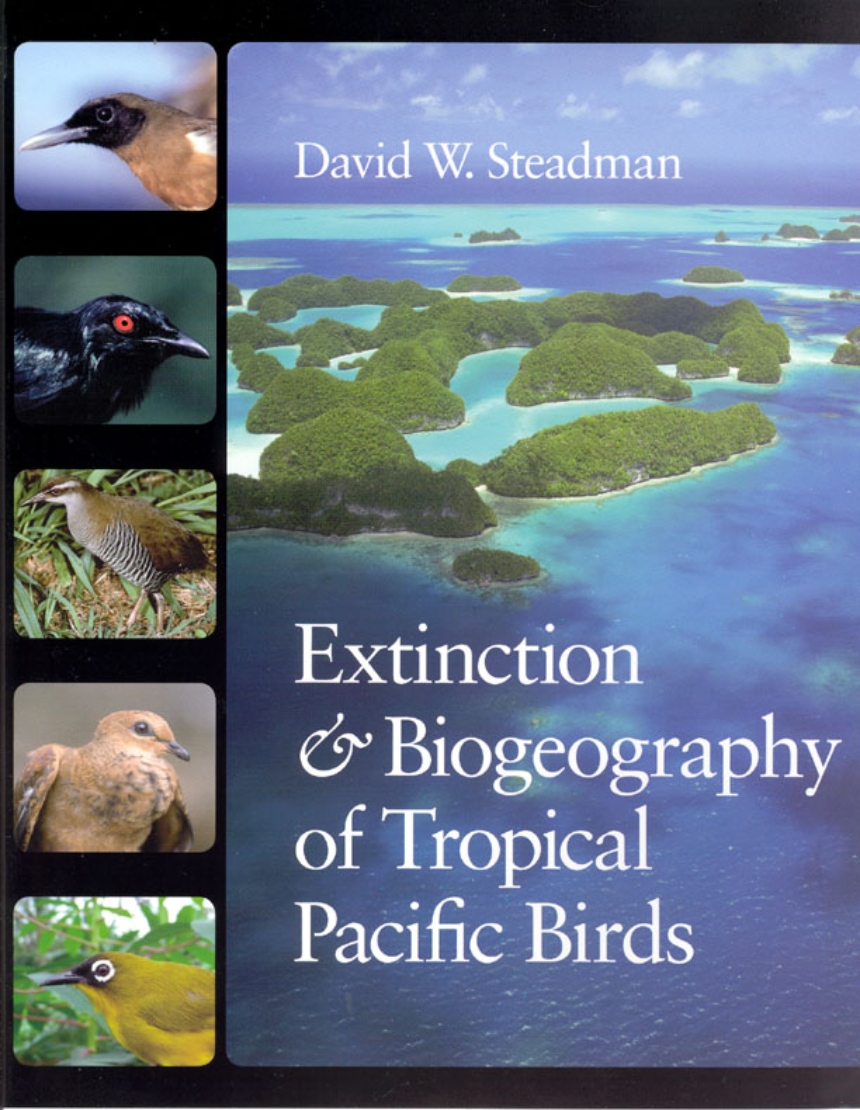Extinction and Biogeography of Tropical Pacific Birds
Sprinkled across the tropical Pacific, the innumerable islands of Oceania are home to some of the most unique bird communities on the planet, and they sustain species found nowhere else on earth. Many of the birds that live in this region are endangered, however; many more have become extinct as a result of human activity, in both recent and prehistoric times.
Reconstructing the avian world in the same way archeologists re-create ancient human societies, David Steadman—a leading authority on tropical Pacific avian paleontology—has spent the past two decades in the field, digging through layers of soil in search of the bones that serve as clues to the ancient past of island bird communities. His years of indefatigable research and analysis are the foundation for Extinction and Biogeography of Tropical Pacific Birds, a monumental study of the landbirds of tropical Pacific islands—especially those from Fiji eastward to Easter Island—and an intricate history of the patterns and processes of island biology over time.
Using information gleaned from prehistoric specimens, Steadman reconstructs the birdlife of tropical Pacific islands as it existed before the arrival of humans and in so doing corrects the assumption that small, remote islands were unable to support rich assemblages of plants and animals. Easter Island, for example, though devoid of wildlife today, was the world’s richest seabird habitat before Polynesians arrived more than a millennium ago. The forests of less isolated islands in the Pacific likewise teemed with megapodes, rails, pigeons, parrots, kingfishers, and songbirds at first human contact.
By synthesizing data from the distant past, Steadman hopes to inform present conservation programs. Grounded in geology, paleontology, and archeology, but biological at its core, Extinction and Biogeography of Tropical Pacific Birds is an exceptional work of unparalleled scholarship that will stimulate creative discussions of terrestrial life on oceanic islands for years to come.
Reconstructing the avian world in the same way archeologists re-create ancient human societies, David Steadman—a leading authority on tropical Pacific avian paleontology—has spent the past two decades in the field, digging through layers of soil in search of the bones that serve as clues to the ancient past of island bird communities. His years of indefatigable research and analysis are the foundation for Extinction and Biogeography of Tropical Pacific Birds, a monumental study of the landbirds of tropical Pacific islands—especially those from Fiji eastward to Easter Island—and an intricate history of the patterns and processes of island biology over time.
Using information gleaned from prehistoric specimens, Steadman reconstructs the birdlife of tropical Pacific islands as it existed before the arrival of humans and in so doing corrects the assumption that small, remote islands were unable to support rich assemblages of plants and animals. Easter Island, for example, though devoid of wildlife today, was the world’s richest seabird habitat before Polynesians arrived more than a millennium ago. The forests of less isolated islands in the Pacific likewise teemed with megapodes, rails, pigeons, parrots, kingfishers, and songbirds at first human contact.
By synthesizing data from the distant past, Steadman hopes to inform present conservation programs. Grounded in geology, paleontology, and archeology, but biological at its core, Extinction and Biogeography of Tropical Pacific Birds is an exceptional work of unparalleled scholarship that will stimulate creative discussions of terrestrial life on oceanic islands for years to come.
480 pages | 108 halftones, 133 line drawings | 8 1/2 x 11 | © 2006
Biological Sciences: Paleobiology, Geology, and Paleontology, Tropical Biology and Conservation
Earth Sciences: Paleontology
Geography: Environmental Geography
Reviews
Table of Contents
Preface
Acknowledgments
Part I
Chapter 1. Geography and Geology
Chapter 2. Terrestrial Flora and Fauna
Chapter 3. Human History
Chapter 4. Birds Living and Dead, on Islands and in Museums
Part II
Chapter 5. Melanesia
Chapter 6. West Polynesia
Chapter 7. East Polynesia
Chapter 8. Micronesia and Remote Central Pacific Islands
Part III
Chapter 9. Megapodes
Chapter 10. Rails
Chapter 11. Pigeons and Doves
Chapter 12. Parrots
Chapter 13. Other Nonpasserine Landbirds
Chapter 14. Passerines
Chapter 15. Seabirds
Part IV
Chapter 16. Extinction
Chapter 17. Dispersal, Colonization, and Faunal Attenuation
Chapter 18. Equilibrium and Turnover
Chapter 19. Species-Area Relationships
Chapter 20. Community Ecology
Chapter 21. Conservation Biology
Chapter 22. Conclusions, and Suggestions for Future Research
Appendix
Literature Cited
Index
Acknowledgments
Part I
Chapter 1. Geography and Geology
Chapter 2. Terrestrial Flora and Fauna
Chapter 3. Human History
Chapter 4. Birds Living and Dead, on Islands and in Museums
Part II
Chapter 5. Melanesia
Chapter 6. West Polynesia
Chapter 7. East Polynesia
Chapter 8. Micronesia and Remote Central Pacific Islands
Part III
Chapter 9. Megapodes
Chapter 10. Rails
Chapter 11. Pigeons and Doves
Chapter 12. Parrots
Chapter 13. Other Nonpasserine Landbirds
Chapter 14. Passerines
Chapter 15. Seabirds
Part IV
Chapter 16. Extinction
Chapter 17. Dispersal, Colonization, and Faunal Attenuation
Chapter 18. Equilibrium and Turnover
Chapter 19. Species-Area Relationships
Chapter 20. Community Ecology
Chapter 21. Conservation Biology
Chapter 22. Conclusions, and Suggestions for Future Research
Appendix
Literature Cited
Index
